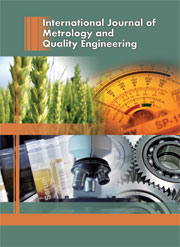Article contents
Calculation of measurement uncertainty for plastic (ABS) material in flexural testing
Published online by Cambridge University Press: 05 June 2013
Abstract
In order to determine mechanical properties of materials various kind of tests can be applied by means of using their tensile strength, lower yield stress, proof stress, impact strength, Brinell, Rockwell and surface hardness, elongation after fracture properties. Among these tests, three point flexural testing method has some advantages such as easy preparation (production) of samples and no gripping problems comparing to tension test. Flexural tests results should be obtained accurately to provide expected testing performance. The measurement uncertainty of flexural tests should be calculated by conducting all effective uncertainty parameters during the test procedure. In this study, the measurement uncertainty of the flexural test of ABS (Acrylonitrile Butadiene Styrene) material was investigated, which is widely used as industrial plastic material in many applications.
Keywords
- Type
- Research Article
- Information
- International Journal of Metrology and Quality Engineering , Volume 4 , Issue 1 , 2013 , pp. 29 - 33
- Copyright
- © EDP Sciences 2013
References
- 4
- Cited by




